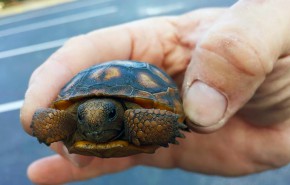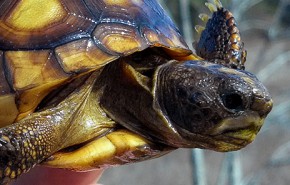Environmental Manager DJ Silverberg, PWS, GTA leads a gopher tortoise relocation project in advance of work in a Florida park, and the fascinating creatures stop by the GAI office on their way to new homes.
Efficient Gopher Tortoise Relocation Speeds Vital Project Work
When popular Gamble Rogers State Recreation Area in Florida’s Flagler Beach was looking to expand its access roads to better accommodate large recreational vehicles, GAI’s DJ Silverberg got the call to manage a gopher tortoise relocation project to give a small but precious community of protected reptiles a new forever home.
“The gopher tortoise is listed as a threatened species in Florida,” said Silverberg, who is an Authorized Gopher Tortoise Agent in the state. “According to Florida Fish and Wildlife Conservation Commission (FWC) regulations, construction preparation or construction work is not permitted within a 25-foot radius of the mouth of a potentially occupied gopher tortoise burrow.” It’s paramount in Silverberg’s mission to help clients fully meet all regulatory requirements in order to enable necessary project work to proceed in a timely manner.
Surveying the Site for Protected Tortoises
“Early on in many projects we’re tasked with performing a qualitative assessment to determine if there are protected species living within the work site,” said Silverberg. A GPS map of the inventoried gopher tortoise burrow locations is then overlaid on a map of the project area to determine if any burrows lay within the 25-foot limit. If so, a gopher tortoise relocation is in order—and Silverberg’s next task is to collect the animals so they can be identified, cataloged, and moved to a safe habitat.
Low-Tech, High-Efficiency Capture Technique
In many work sites, a backhoe can be used to gently excavate the burrows and dig out the gopher tortoises. Not so in the Gamble Rogers Recreation Area, where the Florida Department of Environmental Protection (DEP) seeks to limit the use of equipment that might damage the site’s fragile natural environment. “At this site, we utilized an old-fashioned—but still very effective—method to capture the tortoises,” said Silverberg. “We dig a small pit in front of the burrow entrance, place a 5-gallon bucket into the pit, cover the bucket opening with tinfoil and a thin layer of sand, then wait until it catches the resident tortoise. The process is simple and completely harmless to the tortoises.”
![]()
Once such a ‘bucket trap’ is installed in front of a burrow, it is checked daily for a FWC-required 28 days or until the resident gopher tortoise is captured, whichever comes first.
![]()
Gopher Tortoises Visit GAI and Go on the Record
Before they move to their new homes, the tortoises are measured, weighed, marked, and cataloged for possible future identification. The Gamble Rogers site tortoises made a visit to the GAI Orlando office for this part of the process, during which Silverberg made identifying notches in the edges of their shells.
![]()
“If you’ve ever seen a turtle or tortoise shell, you know that they are covered with many tile-like sections called scutes,” said Silverberg. “There is a number-based system for notching the shells’ outer-edge scutes, and in gopher tortoise relocation this allows us to assign each animal a specific number that we can use to catalog them in case future identification is necessary.”
![]()
![]()
On to a New Forever Home
Next and final stop for the scaly subjects of the Gamble Rogers gopher tortoise relocation project is Rock Springs Run State Reserve located about 30 miles north of Orlando.
“Florida’s DEP likes gopher tortoises that are found on state lands to be relocated to other state lands,” said Silverberg. The gopher tortoises are bound to like it as well: they’ll have every opportunity to thrive in the 14,000-acre state park that includes swamps, creeks, rivers, and the pine forests that are the tortoises’ most suitable habitat.
“The gopher tortoises are charismatic little creatures in my view,” said Silverberg. “And here at GAI, we’ve probably got more than 100 years of combined environmental experience in Central Florida that we’re proud to put to work to benefit both our clients and the priceless wildlife we help preserve.”
Contact GAI Environmental Manager DJ Silverberg for more information about gopher tortoise relocation and other GAI services that help conserve wildlife while being sensitive to project need.
![]() DJ Silverberg, PWS, GTA is a Professional Wetland Scientist who has conducted ecological consulting studies since 1987. He performs preliminary land use assessments, wetland delineations, and listed species evaluations for sites throughout Florida, as well as wetland jurisdictional delineations for local, state, and federal regulatory programs.
DJ Silverberg, PWS, GTA is a Professional Wetland Scientist who has conducted ecological consulting studies since 1987. He performs preliminary land use assessments, wetland delineations, and listed species evaluations for sites throughout Florida, as well as wetland jurisdictional delineations for local, state, and federal regulatory programs.


